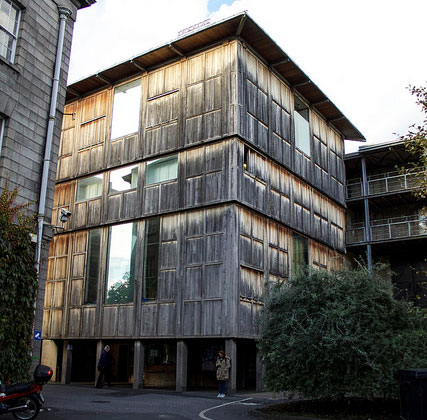
Positioned in the northeast corner of New Square, the Samuel Beckett Theatre stands tall and grand, like an ancient tree at the centre of a forest. While it works in perfect harmony with the other trees of the forest, as a building it could not be more different from its neighbours. It’s the under-the-radar cool kid who wore Cos in playschool, the spicy Dorito of a multipack. It is cool, bold and aloof in equal measure. It radiates theatricality from its very bones. The vertical mass of the south facade standing on wooden stilts and the oak panelling fading into a silvery grey are reminiscent of the snow-white hair of an OAP. Perhaps it is most beautiful at dawn, with the rising tangerine sun illuminating the east wall in a warm bath of ochre light.
Upon entry, a visitor moves through the stilted facade under a dramatically low overhang. The experience is akin to venturing into the mouth of a cave or an old medieval townhouse. You are met by a curved glass window to the right and a wooden stairway to the left. This is the principal staircase of the building, a compact spine. The warm, wooden hues lend a domestic character to the space. These steps lead to the first floor, which splits into two airy, double height vaults. The main theatre is to the rear, its breeze-block walls smothered in a dark cloak of black paint.
A monumental tripartite window adorns the front of the building, with views of the rugby pitch and New Square. Inside is the common room belonging to DU Players, presided over by a large white tiger perched regally between vials of glitter and vintage adidas. Overhead lies the rehearsal rooms and a smaller performance space, all of which are capped with a pyramidal slate roof, perhaps a nod to the Ulster Bank towers in the distance.
Aptly, the architects De Blacam & Meagher attempted to reinterpret a timber Shakespearean playhouse with their design. They are also responsible for the Atrium, the beamed wooden interior of which bares striking similarities to the Samuel Beckett Theatre. Indeed, De Blacam & Meagher seemed to have drawn from a multitude of curious structures when plotting the building. One of which was the Teatro del Mondo, a temporary floating theatre designed by Aldo Rossi and the crowning jewel of the 1979 Venice Biennale. It was a tall wooden box of similar personality.
On a whole, the building is one of the most idiosyncratic on campus, providing a home for the quirky, the shooting stars and the glitter aficionados. It is a creative mosh pit, an intriguing bubble where reality blurs like a mirage. It fulfils its role with beauty and precision, a classic case of “theatre by name, theatrical by nature”.






